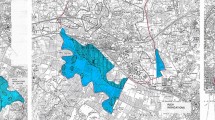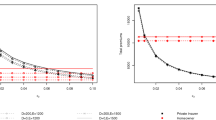Abstract
This paper explores options for programs to be put in place prior to a disaster to avoid large and often poorly-managed expenditures following a catastrophe and to provide appropriate protection against the risk of those large losses which do occur. The lack of interest in insurance protection and mitigation by property owners and by public sector agencies prior to a disaster often creates major problems following a catastrophic event for victims and the government. Property owners who suffer severe damage may not have the financial resources easily at hand to rebuild their property and hence will demand relief. The government is then likely to respond with costly but poorly targeted disaster assistance. To avoid these large and often uneven ex post expenditures, we consider the option of mandatory comprehensive private disaster insurance with risk-based rates. It may be more efficient to have an ex ante public program to ensure coverage of catastrophic losses and to subsidize low income residents who cannot afford coverage rather than the current largely ex post public disaster relief program.
Similar content being viewed by others
References
Bourne, Joel K. (2004). “Gone with the Water,” National Geographic October.
Burby, Raymond J. et al. (1991). Sharing Environmental Risks: How to Control Governments’ Losses in Natural Disasters. Boulder: Westview Press.
Camerer, Colin and Howard Kunreuther. (1989). “Decision Processes for Low Probability Events: Policy Implications,” Journal of Policy Analysis and Management 8, 565–592.
Doherty, Neil, Paul Kleindorfer and Howard Kunreuther. (1990). “Insurance Perspectives on an Integrated Hazardous Waste Management Strategy,” Geneva Papers on Risk and Insurance 27, 407–427.
Earthquake Engineering Research Institute. (1998). Incentives and Impediments to Improving the Seismic Performance of Buildings. Oakland, CA: Earthquake Engineering Research Institute.
Federal Emergency Management Agency. (2006). Robert T. Stafford Disaster Relief and Emergency Assistance Act, as amended by Public Law 93–288, June, 2006. Online at http://www.fema.gov/ library/stafact.shtm (accessed July 5, 2006).
Grace, Martin F., Robert W. Klein and Paul R. Kleindorfer. (2004). “Homeowners Insurance with Bundled Catastrophe Coverage,” Journal of Risk and Insurance 7, 3.
Grossi, Patricia and Howard Kunreuther. (2005). Catastrophe Modeling: A New Approach to Managing Risk. New York: Springer.
Harrington, Scott. (2000). “Rethinking Disaster Policy,” Regulation Spring 40–46.
Harrington, Scott. (2006). “Rethinking Disaster Policy After Hurricane Katrina,” In: R. Daniels, D. Kettl, and H. Kunreuther (eds.), On Risk and Disaster: Lessons from Hurricane Katrina. Philadelphia: University of Pennsylvania Press.
Hartwig, Robert and Claire Wilkinson. (2005a). Public/Private Mechanisms Handling Catastrophic Risk in the United States. New York: October, Insurance Information Institute.
Hartwig, Robert and Claire Wilkinson. (2005b). The National Flood Insurance Program. New York: October, Insurance Information Institute.
Hogarth, Robin and Howard Kunreuther. (1995). “Decision Making Under Ignorance: Arguing with Yourself,” Journal of Risk and Uncertainty 10, 15–36.
Hood, Jim. (2005). “A Policy of Deceit.” New York Times, November 19.
Insurance Information Institute. (2005). “Flood Insurance: Facts & Figures.” November 15.
Kahneman, Daniel and Amos Tversky. (1979). “Prospect Theory: An Analysis of Decision Under Risk,” Econometrica 47(2), 263–291.
Kaplow, Louis. (1991). “Incentives and Government Relief for Risk,” Journal of Risk and Uncertainty 4, 167–175.
Kunreuther, Howard. (1973). Recovery from Natural Disasters: Insurance or Federal Aid? Washington, D.C.: American Enterprise Institute for Public Policy Research.
Kunreuther, Howard, et al. (1978). Disaster Insurance Protection: Public Policy Lessons. New York: John Wiley and Sons.
Kunreuther, Howard, Warren Sanderson and Rudolph Vetschera. (1985). “A Behavioral Model of the Adoption of Protective Activities,” Journal of Economic Behavior and Organization 6, 1–15.
Kunreuther, Howard, Nathan Novemsky and Daniel Kahneman. (2001). “Making Low Probabilities Useful,” Journal of Risk and Uncertainty 23, 103–120.
Kunreuther, Howard and Mark Pauly. (2004). “Neglecting Disaster: Why Don’t People Insure Against Large Losses?” Journal of Risk and Uncertainty 28, 5–21.
Kunreuther, Howard. (2006). “Comprehensive Disaster Insurance: Has its Time Come?” In: R. Daniels, D. Kettl, and H. Kunreuther (eds.), Risk and Disaster: Lessons from Hurricane Katrina. Philadelphia: University of Pennsylvania Press.
Kydland, Finn and Edward Prescott. (1977). “Rules Rather Than Discretion: The Inconsistency of Optimal Plans,” Journal of Political Economy 85, 473–91.
Litan, Robert. (2006). “Sharing and Reducing the Financial Risks of Future Mega-Catastrophes,” Issues in Economic Policy 4. Washington, D.C.: Brookings Institute.
Magat, Wes, W. Kip Viscusi and Joel Huber. (1987). “Risk-dollar Tradeoffs, Risk Perceptions, and Consumer Behavior,” In: W. Viscusi and W. Magat (eds.), Learning about Risk. Cambridge, MA: Harvard University Press.
McFadden, Daniel. (2006). “Free Markets and Fettered Consumers.” American Economic Review 96, 5–29.
Moss, David. (2002). When All Else Fails: Government as the Ultimate Risk Manager. Cambridge, MA: Harvard University Press.
New Orleans Times-Picayune. (2002). “Washing Away: Special Report from the Times-Picayune,” The New Orleans Times-Picayune June 23–27.
Palm, Risa. (1990). Natural Hazards: An Integrative Framework for Research and Planning. Baltimore: Johns Hopkins University Press.
Palm, Risa. (1995). Earthquake Insurance: A Longitudinal Studies of California Homeowners. Boulder: Westview Press.
Pasterick, Edward T. (1998). “The National Flood Insurance Program,” In: Howard Kunreuther and Richard J. Roth, Sr. (eds.), Paying the Price: The Status and Role of Insurance Against Natural Disasters in the United States. Washington, D.C.: Joseph Henry Press.
Risk Management Solutions. (2004). “The Northridge, California Earthquake. A 10-Year Retrospective,” May.
Roth, Richard Jr. (1998). “Earthquake Insurance in the United States,” In: Howard Kunreuther and Richard J. Roth, Sr. (eds.), Paying the Price: The Status and Role of Insurance Against Natural Disasters in the United States. Washington, D.C.: Joseph Henry Press.
Smetters, Kent. (2004). “Insuring Against Terrorism: The Policy Challenge,” In: R. Litan and R. Herring (eds.), Brookings-Wharton Papers on Financial Services, 139–182.
Tobin, Richard and Corinne Calfee. (2005). The National Flood Insurance Program’s Mandatory Purchase Requirement: Policies, Processes, and Stakeholders. Washington, D.C.: American Institutes for Research.
Towers, Perrin. (2005). “Hurricane Katrina: Analysis of the Impact on the Insurance Industry,” Available online at http://www.towersperrin.com/tillinghast/publications/reports/Hurricane_Katrina/katrina.pdf.
Tversky, Amos, Shmuel Sattath and Paul Slovic. (1988). “Contingent Weighting in Judgment and Choice,” Psychological Review 95, 371–384.
United States Government Accountability Office. (2005). Army Corps of Engineers: History of the Lake Pontchartrain and Vicinity Hurricane Protection Project. Statement of Ann Mittal before the Committee on Environment and Public Works, U.S. Senate, November 9.
Author information
Authors and Affiliations
Corresponding author
Additional information
JEL Classification · G22 · H23 · H44
Howard Kunreuther is Cecilia Yen Koo Professor of Decision Sciences and of Business and Public Policy at The Wharton School of The University of Pennsylvania, and Co-Director of the Wharton Risk Management and Decision Processes Center.
Mark Pauly is Bendhelm Professor of Health Care Systems at the Wharton School of the University of Pennsylvania.
Rights and permissions
About this article
Cite this article
Kunreuther, H., Pauly, M. Rules rather than discretion: Lessons from Hurricane Katrina. J Risk Uncertainty 33, 101–116 (2006). https://doi.org/10.1007/s11166-006-0173-x
Issue Date:
DOI: https://doi.org/10.1007/s11166-006-0173-x




